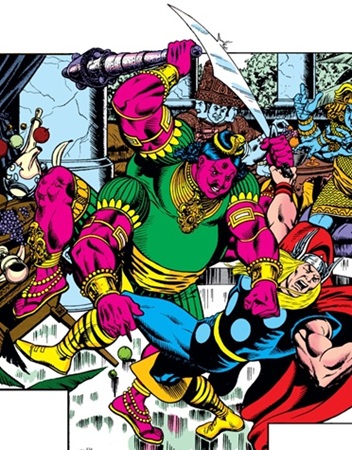
SHIVA
Real Name: Shiva (also Siva)
Identity/Class: Hindu god
Occupation: God of destruction and rebirth
Group Membership: Daevas (Hindu gods), Trimuti (Brahma, Vishnu), Council Elite
Affiliations: Angkor,
Dansen
Macabre, the Cult
of Kara-Kai
Enemies: The Rakshasas
Known Relatives: Daksha (father-in-law), Himavat (father-in-law), Ammavaru (mother), Brahma, Vishnu (brothers),
Parvati (wife), Kâli (wife),
Ganesha,
Skanda (sons),
Dharma, Kama (nephews), Padma, Vach (nieces),
Lakshmi, Sarasvati (sisters-in-law)
Aliases: Sharevar
(Persian name), Nataraja, Jyotirlinga
Base of Operations: Kailasa in the dimension of Nirvana
First Appearance: (Mentioned; see comments) Real Mystery Magazine
I#2 (July, 1940); (seen) Thor I#301 (November, 1980)

Powers/Abilities: Shiva possesses greater than normal powers of
the Hindu gods. He has incredible strength to match Thor (Class 100)
and endurance as well as remarkable speed and reflexes in his four
arms. He also has considerable powers to manipulate energy, but not as
far as Vishnu's extent. In addition, he can project energy from his
third eye, which enables him to mentally enslave and control others,
as long as they remain in its direct path. He carries an arsenal of
weaponry, including his lightning spear, which can release lighting in
the form of bolts or cages.
He is, however, much more powerful in his native dimension than he
would be in another, such as Asgard.
Height:
Unrevealed
Weight: Unrevealed
Eyes: Unrevealed
Hair: Black
History:
(Hindu Myth) - Shiva is the
part of the ruling triumvirate of gods that also includes Vishnu
and Brahma,
who are his brothers only in the sense of equality in power and role.
The three rose to ruling council of the Hindu gods after Vishnu
overthrew the Rakshasas, the Hindu demons who overthrew their Vedic
ancestors.
(BTS - Shiva apparently granted power to the woman who
became Dansen Macabre.
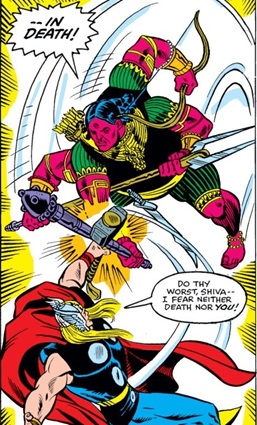
(Thor I#301) - In the wake of Ragnarok, Thor appeared in
Nirvana seeking a portion of the life-energies necessary to resuscitate
the Asgardians. Vishnu, Brahma and Shiva however put the option to a
vote and decided not to donate the energies, preferring rather they go
on to other immortals. A clash of tempers, however, caused a
confrontation between Shiva and Thor that lead back to Bifrost, the
rainbow bridge to Asgard. Realizing he was overwhelmed by the
thunder-god's passion, Shiva formulated an uneasy truce and relinquished
the energies Thor wanted; the two subsequently separated with uneasy
tension.
(Thor Annual I#10) - Indra
assisted Thor, Apollo,
Tawa, Quetzalcoatl
and Shango
against Demogorge
the God Eater. Although briefly consumed by the entity himself,
Indra was rescued by Thor.
INDRA TOLD THOR THAT IT WAS IN FACT HE WHOM THOR BATTLED PREVIOUSLY
(in issue #301), NOT SHIVA--THIS WAS PART OF SOME UNEXPLAINED
DECEPTION. (see comments)
(Thor I#398) - While in Nirvana, Shiva overheard the
Enchantress's primal scream over the death of her lover, Heimdall.
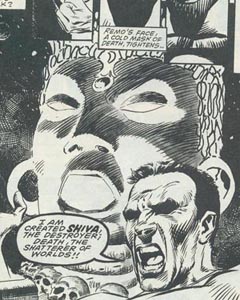
(Thor II#61) - Thor was called before the Council Elite to
be tested for worthiness to join them, as a replacement for Odin--Shiva
was present at this meeting, and it was he who insisted that the
newcomer perform the Koronkakkta, a ritual to test his character. Thor
was judged as having failed the test.
(Thor II#65) - Members of the Council Elite were concerned
when Thor's actions on Earth violated the Council's Covenant of
Noninterference; Shiva demanded for arms to be taken up against the
Asgardian before it was too late.
Comments: Adapted by Mark Gruenwald, Ralph Macchio and Keith Pollard for Thor.
The use of Shiva, one of the principal gods of the Hindu religion,
and his defeat at the hands of Thor, did not sit well with members of one
of the largest, thriving religions on the planet. As a result, Marvel
ret-conned that appearance to be Indra posing as Shiva.
According to Will U:
"Shiva appears in Thor Annual 10 claiming to be
Indra, who is a golden-skinned deity. The ruse is confusing, but easily
explained above. The confusion can be made as thus: When Vishnu, Brahma
and Shiva ascended to heaven, they replaced Varuna, Mitra and Rudra,
respectively. Rudra was a storm-god and a sort of mentor to Indra
(Rudra's sons, the Maruts, even followed Indra into battle). Several
hypothetical translations think Rudra and Shiva to be the same deity,
but their families and descriptions don't line up. Furthermore, Rudra
and Indra were more water gods; Shiva was also a god of volcanoes and
fire.
However, Marvel lists the character appearances as
Indra, not Shiva.--Snood.
In Hindu myth, Shiva rides a bull named Nandi, who is also
a god in animal form.
Discussions on Shiva:
According to Pranshu
B. Saxena, who "is a
believer of sanatan dharma or what the foreigners refer to as Hinduism.
Hindu originally means simply a person living in India (more accurately
east of river Sindhu (Indus)).
The concept of religion as you say in the west is very, very different
from that in India."
- Shiva had no mother, Daksha was father-in-law;
Vishnu and Brahma are brothers in the sense of equality of powers or
role. Kâli is wife of Shiva, Himavat is also father-in-law.
- Maruts the storm gods, are not sons of Rudra and
are half-brothers to Indra actually. There are 13 Rudras, all
affiliated to storms and to Shiva.
- Varuna and Mitra are the older brothers to Indra
and Vishnu who are real brothers.
- Vishnu was also born as Yamana , younger brother to
them.
- Mitra is the same as Surya.
- The ancient Vedic storm god Rudra fused with
Sarasvati-Indus valley god Pashupati Anddravidan god to form the
modern Shiva.
Pranshu continues with the further discussion:
- "There are at least 900 million Hindus, so
according to an actual amorphous definition of Hinduism, it implies
there can be 900 million different pantheons (that would explain why
we don't have fatwa) so in a way even Marvel 's versions can be
accepted as a new pantheon (note: Yogavasistha did talk about
infinite universes :-)). But of course, we are not truly free of
prejudices and fears and hence Marvel 's representation of Hindu
gods (or even in Xena) would seem an attack or even unintended
attempt to create offense.
- I believe Marvel Comics makes a mockery of Indian
belief system by using Hindu gods like Shiva, Vishnu. The concept
that there is a realm of Hindu gods is laughable. According to Yoga
Vasishta written around 400 BC, there are countless universes, each
atom has in itself another universe. Each action initiates a choice
and each choice creates a new universe. But Shiva, Brahma and Vishnu
transcend all.
- Why western story-tellers always go for the big
guys is not understood. There are levels of power structure and if
Marvel comic writers had taken pains, they should have used gods
like Indra, who will still be too powerful for say Thor or Superman.
- In recent Wonder Woman about couple of years ago,
DC handled it differently when they used Rama as a war god and
possible love interest for Wonder Woman!! Rama is worshiped by
millions of women in India as the ideal man and husband whose sole
interest is his wife Sita, who was formed from earth just like
Wonder Woman. As Rama is also born human and possibly died and shown
having some human frailties like bowing to popular pressures of
ruling etc., that depiction was much better."
- The first lines of Rigveda mentions a deity who is
unnamed and was probably existent before existence and is probably
represented by symbol OM. He is the God? though a question mark
always is put next to the prayer.
- Their strength is said to be derived from the faith
of the followers. Indra all too often loses his throne to a Rakshasa
warlord (Rakshasa
wrongfully translated as "demon") or other due to
faith of the followers in that warlord. All too often the conqueror
loses out to either Vishnu or Shiva or Brahma or their incarnations
or forms after crossing the boundary line, absolute power corrupts
absolutely. Thus no one has absolute power and Indra is in power as
he can resist the corruption of power. He himself has been
overthrown due to his own corruptions. One soul is said to have been
Indra 19 times and still could not discover the eternal truth. Also,
the wisdom is more respected than strength.
- There is a whole set of lower gods, god tribes,
races like Yakshas, Innars, Vanars, Garudas, 8 main snake races,
semi-immortal humans or human offspring of gods or whole cornucopia
of literature from Panchatantra, Katha Sarita Sagara, Puranas,
Gathas, Hitopdesha, Smritis, Upapuranas, Sangama, Mahabharata, et
al. India has been producing heroic literature for only 3500 years.
- Also a very important point to understand is that
there is no concept of evil but there are hells, 21, I think--nobody
is fully bad or fully good. Eve Dharma raja (Yama)'s son Yudhisthara
spent time in hell for telling a lie.
- Anyway, the source <for this information>
can be Skanda Purana and Bhagvata Purana which I have here in the
USA.
Another opinion courtesy of Shubh Karan:
- You should refer to the Indian comics based on Indian
Gods and Hindu Mythology....Shiva is all powerful, with immeasurable
strength and power....you can't classify his strength as class 100,
etc....he is the 'Destroyer', and (fortunately for everyone),
generally stays out of the affairs of the world. If he opens his third
eye, or gets agitated and dances the Tandav, that's it, man, end of
the world - Brahma'll have to start rebuilding again....gods such as
Indra could be classified as say class 100 strength, etc - they are
defeatable. Shiva and Vishnu are approached by other gods when things
get out of hand for them. In other words, you approach them when
nothing else works, and they always fix things no matter what. In his
human incarnations, Vishnu is considerably less powerful, but powerful
enough to handle the crisis at hand (he usually doesn't call on his
full power, unless required)....Marvel should make gods like Thor,
Hercules and Zeus
battle Hindu gods of the level of Indra (King of the Daevas, hence
probably equivalent of Zeus' power and strength level). If Thor
approached Shiva, and angered him, Shiva'd just open his third eye and
incinerate Thor into nothingness....Thor'd end up being reborn
somewhere, and finally, Shiva'd grant him forgiveness (if Thor behaved
really well, and various other gods appealed to Shiva on Thor's
behalf), and he would take his original form....ain't no defeating
Shiva man!! All gods fear him!
- Also, the Marvel comics artists should check out the
depiction of Shiva in Indian Amar Chitra Katha comics - it's far
superior to the drawings done by Marvel - ok, maybe the coloring,
shading etc of Marvel artists are usually better than Amar Chitra
Katha (AMC), but the AMC artists capture the essence of Shiva much
better - he's lean and muscular, the body of an Ascetic who practices
intolerably hard penance and self denial, and stays away from the
world atop Mount Kailasa....also lithe and supple, an expert
practitioner of Yoga, and the greatest dancer in the world.....he's
not a pumped up heavy muscled freak (looking as though he's been blown
up with steroids) who couldn't shake a leg....he also has very long
hair that is always tied up in a bun - he once caught and entrapped
the River Ganges (also a goddess) in that bun...and always has a snake
around his neck - a king cobra.
- yeah, that's probably why Marvel decided to reveal
that it was actually Indra whom Thor had fought in those issues.
Class 100 strength includes anything > 100 tons, as it is
difficult to quantify beyond that. You do have to remember that
there is a difference between Marvel's characters, and the
characters from religion.
While Marvel may have goofed in having Shiva fight on the level of
Thor (although Shiva was overpowering him in Nirvana), it would make
more sense to have him be more an the level of Zeus or Odin, again,
only in the MU.
Also, if you cling to the belief that it was really Shiva, and not
Indra, you could just think that Shiva was merely toying with Thor, and testing his abilities, only
feigning defeat for his own purposes--Snood.
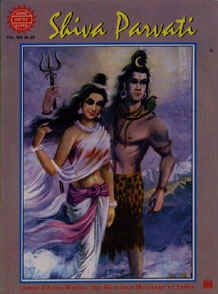
- I'm attaching a much better drawing of Shiva done by
Amar Chitra Katha comics...much better than what Marvel has done, that
is...it's a small picture, but gives an idea...there's a whole world
of gods, and Indra is their king...so he's like as powerful as Zeus or
Odin....then there's the Trinity - Brahma Vishnu and Mahesh (Shiva),
who transcend all universes and are all powerful....think of them as
the kings of the Celestials or something...all powerful with untold
power...they could grow to over 2000 feet if they wanted to, or stand
at the size of a normal man - whatever they choose. And Shiva is
the most dangerous and volatile of them...the easiest to anger, but
also the easiest to please and obtain favor or powers from...known as
Bhole (simple thinking) Shankar, who will grant Boons to anyone,
whether good or bad, if they perform sufficiently severe penance and
meditation (it would usually have to encompass several rebirths,
so its pretty hard)...if he's pleased, he'll grant them a wish....if
that leads to trouble for the world/worlds, well that's that
then....let the other gods handle it...if they all fail and it comes
back to Shiva and he's angered he'll just incinerate the guy...
- If it was depicted that Shiva had some respect for Thor
because Thor was a mighty powerful and honorable god himself, so Shiva
decided not to destroy him
instantly, but to test his passion by seeing how well Thor would
battle, and whether Thor would be willing to battle to the point of
his death, and then Shiva
pleased with the effort put in by Thor would grant him what he wished
instead of killing Thor, it would be acceptable...
Will defends his claim
that it is Shiva, and not Indra, in both Thor#301 and Annual#10:
- As gods, they would both be able to change form,
however, in the earlier appearance, Shiva is obviously more
concerned about reviving gods past their prime over ascendant gods
as the Hindu gods. This would be typical for him since Indra is
basically a Hindu Hercules caring more about getting drunk and
having adventures. In the mythology, Indra heard about how the
dragon Vritra was causing droughts on Earth. After getting
rib-snorting drunk on amrita (a Hindu nectar), he charged Earth and
killed the dragon by drowning it since it was immune to weapons. He
was severely reprimanded since Vritra--despite his nature--was a
friend and ally of Vishnu, a minor sun god at the time. The gods
slew Airvariat, Indra's elephant mount, and used the beast's life
energies and head to revive Ganehsa, who was near death. This is how
Ganehsa became the elephant-headed god of wisdom we see on Apu's
counter on The Simpsons."
Again, it's a matter of whose personality
actually fits the deity. Indra would have most likely pushed Thor
aside and tried killing Demogorge on his own, that was more his
nature. Plus, Indra and Vishnu have been on the outs for a long
time. Despite their boyhood friendship, Vishnu would be holding him
back in the Hindu Pantheon. Indra had major clout in the old Vedic
Pantheon, but his role was greatly diminished under the Hindu
Pantheon. He would not be allowed to impersonate Shiva, a major
deity with worshipers today, and he would not be able to pull it off
in front of Vishnu, Shiva nor Brahma.
In OHotMU 2006#3 it was confirmed that Indra
impersonated Shiva at least on one occasion.
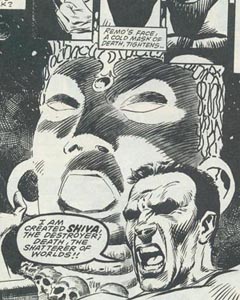
According to John McDonagh:
Before appearing in a Marvel magazine series, The Destroyer, Remo
Williams, originated in a series
of paperback books. A policeman was framed for murder, he became
a special government assassin for the agency CURE. Trained by Chiun,
he developed mystical martial arts powers. Unarmed and dangerous, he
discovered he was an avatar of Shiva.
The place of the Destroyer in the Marvel Universe is a
little uncertain. Using the idea that the adventures could have taken
place in real time (don't you feel older, thinking that the origin of
the Fantastic Four did not take place until after the early 1990s),
you could fit them in. Admittedly, in Destroyer I#1 (magazine), a
character says "Who do you think you are, the Hulk?". However,
that could have been a reference to Xemnu
the Titan.
I recently purchased a copy of Adventure House's
reprint of Real Mystery Magazine I#2 (July, 1940). This is one of
Martin Goodman's "shudder pulps." Since it's been established that
Goodman's magazines are 616 stories (with the probable exceptions of
his sci-fi stories set in the future), I've been looking through
whatever copies I can of his magazines for anything of particular
interest for 616 continuity/history.
I noticed that the main villain in the story "Mates for Hell's
Half-World Minion," Anya Prami the Priestess of Anguish, says "I tell
you I will destroy every young person in this city--destroy them in a
madness and horror such as you never dreamed of! Before Siva, Eighth
Avatar of Vishnu, I swear it!" Shiva never actually appears in the
story, but this is probably the first (publication-wise) reference to
him in a 616 story.
Luke Van Horn
New and additional images by Ron Fredricks.
Profile by William Uchtman. Edited/Revised by Snood.
Updates by Markus Raymond & Ron Fredricks.
Clarifications:
Shiva should not be confused with:
- Shiva
(Dr. Si Fan Chung) - of the Nest--Marvel Team-Up Annual#1
- Shiva
- the computer program designed to kill those involved with the Weapon
X program--Wolverine II#48
- any other characters with similar names
images: (without ads)
Thor I#301, cover (main image - Shiva battles Thor)
Thor I#301, p15, pan7 (headshot - Shiva)
Thor I#301, p16, pan1 (Shiva battles Thor)
Thor II#61, p6, pan7 (Shiva at Council Elite meeting)
Appearances:
Thor I#301 (November, 1980) - Mark Gruenwald & Ralph Macchio (writers), Keith Pollard (pencils), Chic Stone (inks), Jim Salicrup (editor)
Thor Annual I#10 (1982) - Mark Gruenwald & Alan Zelenetz (writers), Bob Hall (pencils), Rick Bryant, Joe Rubinstein, Andy Myshynsky, Al Gordon & Kevin Dzuban (inks), Mark Gruenwald (editor)
Thor I#398 (December, 1988) - Tom DeFalco (writer), Ron Frenz (pencils), Don Heck (inks), Ralph Macchio (editor)
Thor II#61 (May, 2003) - Dan Jurgens (writer), Ben Lai (pencils), Ray Lai (inks), Tom Brevoort (editor)
Thor II#65 (May, 2003) - Dan Jurgens (writer), Ben Lai (pencils), Ray Lai (inks), Tom Brevoort (editor)
First posted: 01/23/2002
Last updated: 06/19/2025
Any Additions/Corrections? please let me know.
Non-Marvel
Copyright info
All other characters mentioned or pictured are ™ and © 1941-2099
Marvel Characters, Inc. All Rights Reserved. If you like this stuff, you
should check out the real thing!
Please visit The Marvel Official Site at: http://www.marvel.com
Special Thanks to
www.g-mart.com for hosting the Appendix, Master List, etc.!
Back
to Characters





